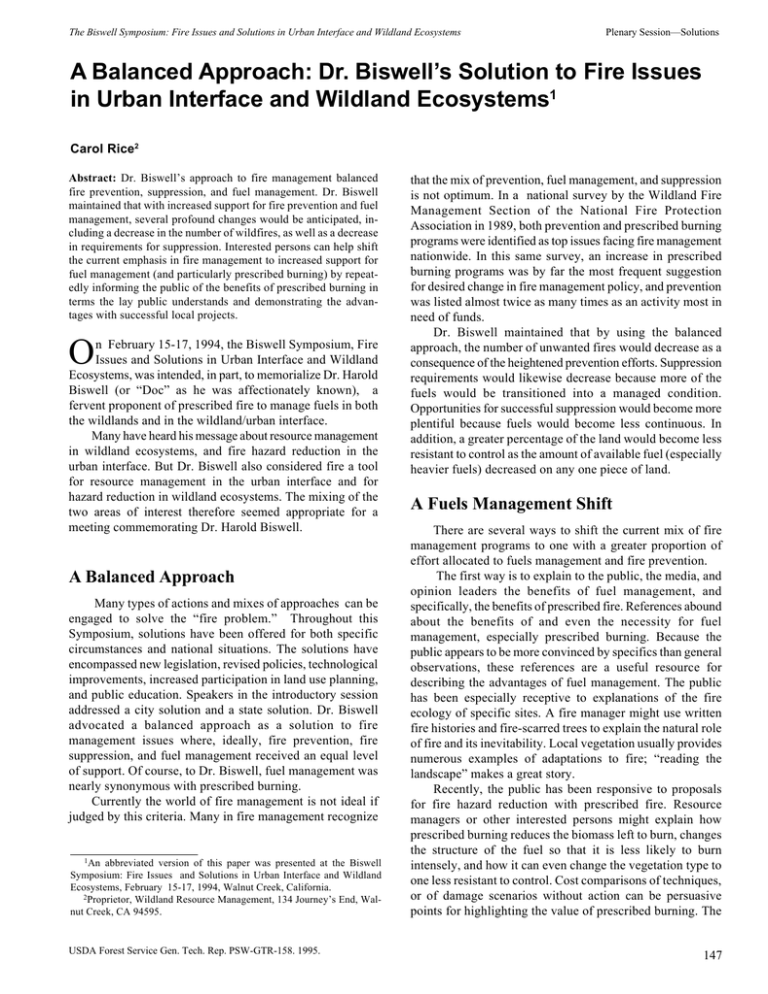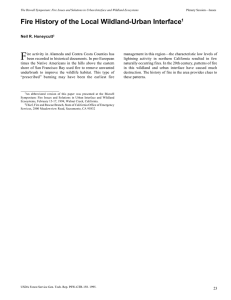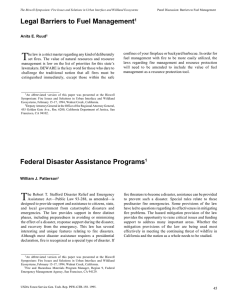A Balanced Approach: Dr. Biswell’s Solution to Fire Issues
advertisement

The Biswell Symposium: Fire Issues and Solutions in Urban Interface and Wildland Ecosystems Plenary Session—Solutions A Balanced Approach: Dr. Biswell’s Solution to Fire Issues in Urban Interface and Wildland Ecosystems1 Carol Rice2 Abstract: Dr. Biswell’s approach to fire management balanced fire prevention, suppression, and fuel management. Dr. Biswell maintained that with increased support for fire prevention and fuel management, several profound changes would be anticipated, including a decrease in the number of wildfires, as well as a decrease in requirements for suppression. Interested persons can help shift the current emphasis in fire management to increased support for fuel management (and particularly prescribed burning) by repeatedly informing the public of the benefits of prescribed burning in terms the lay public understands and demonstrating the advantages with successful local projects. O n February 15-17, 1994, the Biswell Symposium, Fire Issues and Solutions in Urban Interface and Wildland Ecosystems, was intended, in part, to memorialize Dr. Harold Biswell (or “Doc” as he was affectionately known), a fervent proponent of prescribed fire to manage fuels in both the wildlands and in the wildland/urban interface. Many have heard his message about resource management in wildland ecosystems, and fire hazard reduction in the urban interface. But Dr. Biswell also considered fire a tool for resource management in the urban interface and for hazard reduction in wildland ecosystems. The mixing of the two areas of interest therefore seemed appropriate for a meeting commemorating Dr. Harold Biswell. A Balanced Approach Many types of actions and mixes of approaches can be engaged to solve the “fire problem.” Throughout this Symposium, solutions have been offered for both specific circumstances and national situations. The solutions have encompassed new legislation, revised policies, technological improvements, increased participation in land use planning, and public education. Speakers in the introductory session addressed a city solution and a state solution. Dr. Biswell advocated a balanced approach as a solution to fire management issues where, ideally, fire prevention, fire suppression, and fuel management received an equal level of support. Of course, to Dr. Biswell, fuel management was nearly synonymous with prescribed burning. Currently the world of fire management is not ideal if judged by this criteria. Many in fire management recognize 1An abbreviated version of this paper was presented at the Biswell Symposium: Fire Issues and Solutions in Urban Interface and Wildland Ecosystems, February 15-17, 1994, Walnut Creek, California. 2Proprietor, Wildland Resource Management, 134 Journey’s End, Walnut Creek, CA 94595. USDA Forest Service Gen. Tech. Rep. PSW-GTR-158. 1995. that the mix of prevention, fuel management, and suppression is not optimum. In a national survey by the Wildland Fire Management Section of the National Fire Protection Association in 1989, both prevention and prescribed burning programs were identified as top issues facing fire management nationwide. In this same survey, an increase in prescribed burning programs was by far the most frequent suggestion for desired change in fire management policy, and prevention was listed almost twice as many times as an activity most in need of funds. Dr. Biswell maintained that by using the balanced approach, the number of unwanted fires would decrease as a consequence of the heightened prevention efforts. Suppression requirements would likewise decrease because more of the fuels would be transitioned into a managed condition. Opportunities for successful suppression would become more plentiful because fuels would become less continuous. In addition, a greater percentage of the land would become less resistant to control as the amount of available fuel (especially heavier fuels) decreased on any one piece of land. A Fuels Management Shift There are several ways to shift the current mix of fire management programs to one with a greater proportion of effort allocated to fuels management and fire prevention. The first way is to explain to the public, the media, and opinion leaders the benefits of fuel management, and specifically, the benefits of prescribed fire. References abound about the benefits of and even the necessity for fuel management, especially prescribed burning. Because the public appears to be more convinced by specifics than general observations, these references are a useful resource for describing the advantages of fuel management. The public has been especially receptive to explanations of the fire ecology of specific sites. A fire manager might use written fire histories and fire-scarred trees to explain the natural role of fire and its inevitability. Local vegetation usually provides numerous examples of adaptations to fire; “reading the landscape” makes a great story. Recently, the public has been responsive to proposals for fire hazard reduction with prescribed fire. Resource managers or other interested persons might explain how prescribed burning reduces the biomass left to burn, changes the structure of the fuel so that it is less likely to burn intensely, and how it can even change the vegetation type to one less resistant to control. Cost comparisons of techniques, or of damage scenarios without action can be persuasive points for highlighting the value of prescribed burning. The 147 The Biswell Symposium: Fire Issues and Solutions in Urban Interface and Wildland Ecosystems benefits to fire personnel provided by the training and communication opportunities afforded during prescribed burning may likewise be important to a public who depends on a well-trained fire suppression organization. A prescribed burn is often a media event that should be capitalized upon as an opportunity to contact thousands with a message about the value of such actions and programs. Research has shown that a message needs to be heard 400 times before a person’s opinion will be changed or altered. The message about the benefits of prescribed burning needs to be told many times and in many ways simply to reach many people. By the end of any outing, field trip or workshop, Dr. Biswell had told the story of prescribed burning’s benefits repeatedly, but not redundantly. Telling the story about prescribed burning clearly, stated for an intelligent but currently uninformed audience, is very important. Dr. Biswell often quoted Albert Einstein, who suggested that a person did not really understand a concept if he could not explain it to his gardener. Fire managers need to be able to explain the process of fire, its application, and the value of fire’s controlled use in terms that mean something to the audience. A successful local project can illustrate the benefits of fuel management. Fire managers are able to show the applicability of fuel management and prescribed burning in a wide range of circumstances when many successful projects are nearby. Some audiences would prefer to believe fires did and should occur someplace else; thus, the applicability of fire’s use in their particular circumstance is best argued by examples of successful local burns in a variety of conditions. Plenary Session—Solutions Conclusion Those responsible for planning and conducting prescribed burns must persevere to achieve successful projects. Conducting a prescribed burn is not an easy task. Each burn entails challenges regarding scheduling, logistics, communications (to the public and between agencies), air quality management, finances, and many more. However, these projects are nearly always well worth the effort. For example, according to John McMillan (personal communication with author, September 9, 1993), the site of a prescribed burn conducted by staff on the USDA Forest Service’s Pacific Ranger District in California was the only green area visible within miles after the Cleveland Fire of 1992. Although its advantages to this site are obvious, the illustration of prescribed burning’s benefits are also very powerful for potential application elsewhere. Dr. Biswell believed in a balanced approach to fire issues in urban interface and wildland ecosystems, and he worked with a passion to make it so. He did this by repeatedly explaining the benefits of prescribed burning to all those who would listen and many who would not. He told the message about fire’s use in terms all could understand. He always encouraged the wise use of fire and illustrated this with demonstrations. By mimicking Doc’s actions and approach, we will be able to move closer to garnering the support necessary to create that balance Doc was so eager to attain. Reference Rice, Carol L. 1989. Personnel, equipment, budget, costs and issues of Federal fire management programs. Unpublished paper presented to the Wildland Fire Management section of the National Fire Protection Association; 1989 May 19; Boston, Massachussetts. 148 USDA Forest Service Gen. Tech. Rep. PSW-GTR-158. 1995.



